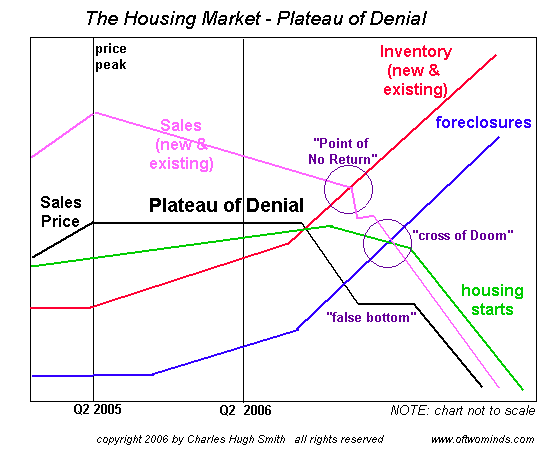

|
| weblog/wEssays archives | home | |
|
The Housing Market - Plateau of Denial (October 23, 2006) I have drawn a chart of the current housing market, showing both the current "Plateau of Denial" (prices remaining stubbornly lofty) even as inventory and foreclosures are rising. Please note the "Cross of Doom" which looms just ahead. 
What this chart depicts is a denial of the laws of supply and demand. Even as housing starts continue at a strong clip (1.8 million units a year), inventories have already reached historic highs (4 million units for sale). Add the rapidly increasing number of foreclosures and REOs ("real estate owned," a nice way of saying the lender now owns the property and is increasingly desperate to unload it) to the supply and you can predict a breakdown of the Plateau of Denial: a point at which sales prices drop sharply in the face of a vast and fast-rising inventory of unsold homes. All these trends have been visible since prices and sales topped out in Q2 2005--over a year ago. Yet prices--at least reported prices--have barely budged in many markets. Those of you familar with stock market technical analysis know of the "Cross of Death"; that's when a stock's 50-day moving average cuts through the 200-day moving average like a hot knife through butter. That marks an undeniable downtrend. Here on my chart, the "Cross of Doom" is marked by plummeting sales meeting sharply rising trendlines of foreclosures. Why is this the "Cross of Doom"? Because when demand crashes--as it inevitably does in eras of oversupply and dropping prices--even as inventory/supply is dramatically increasing, there is simply no way to balance the two forces. There is not enough demand to absorb the flood of supply which is swamping the market. The analogy is a dot-com stock circa late 2000. The supply of stock available for purchase was rising incredibly fast as people tried to exit the market, at the same time that the demand to purchase shares from hopeful/confident investors/speculators took a permanent nosedive in the face of plummeting prices. This is the same mechanism which took dot-com stocks from $348 per share at the peak to 56 cents per share at the bottom. I have also noted the inevitable "false bottom" in which prices temporarily stabilize as overzealous bargain-hunters declare the "bottom" in the housing market and rush in to snap up "bargains." This is akin to buying that dot-com stock for $190. Hey, it's way down from $348--now is the time to buy! It's cheap! Alas, $190 was merely a brief way station on the downslope to 56 cents. I anticipate the feverish cries of the housing bulls, shouting about the intrinsic value of a roof over your head, the rise in U.S. population, "you can always rent it," etc. But oversupply also means an oversupply of rental units, at least in areas of overbuilding, so the rental value of millions of empty units is effectively zero. Let me put this delicately: there is no such thing as intrinsic value. There is only the market price. If there is no demand and a massive oversupply, prices drop to levels which once seemed truly impossible. Eventually the stupendous imbalance between supply and demand is righted, but that process tends to take years in the real estate market. As for population growth, please note just how flexible human beings can be when it comes to dwellings. The San Francisco Bay Area gained hundreds of thousands of new residents during the dot-com heyday of the mid-90s to 2000, and yet 200,000 new units were not built in that time frame. In fact, only a few thousand new units were added to the housing stock of San Jose and San Francisco in those heady years. After dot-com turned to dot-bomb, over 250,000 jobs were lost, and a mass exodus of approximately 200,000 people left the Bay Area. The population actually dropped (check the U.S. Census numbers if you want.) Yet were 100,000 units suddenly vacant? No. People had taken roommates, or rented a room in a house, or doubled up with friends. The point being: enormous numbers of people can move in or out of existing cities with virtually no change in the number of dwellings. Therefore: people won't necessarily fill a million empty houses unless the cost is dramatically cheaper than their current rent. And it is a zero-sum game; if they do move, they would just create a million new vacancies in existing units--or perhaps 1.2 million. And what will the owners of those vacated units do? Drop the price below the competition, unless they want to sit on vacant units. We keep reading about rising rents in Manhattan and San Francisco. Fine--there is still a shortage of available units in those small, hard-to-add-units spots with strong job markets and desirable amenities. But the overbuilding didn't occur in Manhattan or San Francisco; the imbalances lie elsewhere, and that's where the pain will be felt first. So what's the value of a home? Try 10 times annual rent. That's the value as a business which has to make a profit. (Ten times zero is zero.) Disagree? Well, enjoy your stay on the Plateau of Denial, but watch the edge. It may be closer than you think. For more on this subject and a wide array of other topics, please visit my weblog. copyright © 2006 Charles Hugh Smith. All rights reserved in all media. I would be honored if you linked this wEssay to your site, or printed a copy for your own use. |
||
| weblog/wEssays | home |